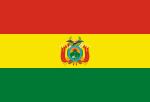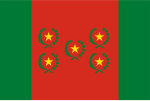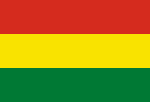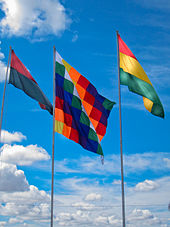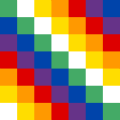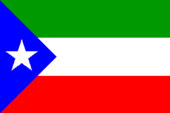Flag of Bolivia
| Flag of Bolivia | |
|---|---|
 |
|
| Vexillological symbol : |
|
| Aspect ratio: | 15:22 |
| Officially accepted: | Introduced: November 5, 1851 Confirmed: July 14, 1888 |
The flag of Bolivia in its current form was first introduced in 1851 and its shape as a horizontal tricolor was influenced by the flag of Colombia . Since 2009 the flag of the indigenous population, the Wiphala , has been an emblem of the national flag .
Description and meaning
The national flag consists of three horizontal stripes of equal size: red at the top , yellow in the middle and green at the bottom . Red stands for the bravery of the Bolivian soldiers, yellow for the wealth of mineral treasures and green symbolizes the fertility of the country.
Coincidentally, these colors correspond to the Pan-African colors , which usually symbolize exactly the same thing. However, there is no historical connection, the colors of Bolivia are older.
In the national flag, the national coat of arms of Bolivia is also shown in the middle of the yellow stripe , sometimes including the blue disc in the background. The national coat of arms is also framed by a laurel wreath in the country's war flag . The sea war flag is blue with the tricolor in the canton. Nine five-pointed yellow stars are lined up along the tricolor. They stand for the nine departments of the country. A tenth, larger star can be found in the lower part of the flight. This symbolizes the Departamento Litoral , an area that Bolivia lost to Chile in the Saltpeter War , but to which Bolivia continues to lay claim because it was its only access to the sea. In the absence of sea access, ships of the Bolivian Navy can only be found on Lake Titicaca and some of the country's larger rivers.
 ? State flag
? State flag
Ghana uses the same tricolor for its national flag with an additional black star in the center of the yellow stripe and with a different aspect ratio.
history
The first national flag of Bolivia was established by the Constituent Assembly on August 17, 1825. The flag consisted of three horizontal stripes, two green and one bright red central stripe half the width of the flag. Five ovals made from laurel and olive branches have been placed in the center of the flag. Within each oval was a gold colored star.
The five ovals with stars presumably stood for the provinces of Charcas , La Paz , Cochabamba , Santa Cruz and Antofagasta at the time . In addition to this “Bandera Mayor”, the law also provided for a second version of the flag ( “Bandera Menor” ), which was only equipped with an oval. This was intended for “non-festive” occasions and today it would be called the “civil flag”, while the more elaborate 5-star version was intended as the “state flag”. Since there are apparently no contemporary images of these flags, one has to rely on the above descriptions for the reconstruction.
On July 25, 1826, however, a new flag design was selected. The law of that time said that the new national flag should be the same as before, but that the five yellow stars should be replaced by an upward yellow stripe. In the center of the flag, the new national coat of arms should be attached within a laurel and olive branch. The exact appearance and type of depiction of the coat of arms is not known. Presumably, however, the coat of arms adopted in 1825 was modified by adding a sixth star. There is also no consensus on the width of the strips. Based on Bolivian sources on flag history, however, the flag from 1826 seems to have been provided with stripes of the same width.

 ? Bandera Mayor (August 17, 1825 to July 25, 1826)
? Bandera Mayor (August 17, 1825 to July 25, 1826)


 ? Bandera Menor (August 17, 1825 to July 25, 1826)
? Bandera Menor (August 17, 1825 to July 25, 1826)


 ? Bandera Mayor (July 25, 1826 to October 31, 1851)
? Bandera Mayor (July 25, 1826 to October 31, 1851)

 ? Bandera Menor (July 25, 1826 to October 31, 1851)
? Bandera Menor (July 25, 1826 to October 31, 1851)
Between 1836 and 1839, Bolivia was part of the “ Peruvian-Bolivian Confederation ” established by the Bolivian dictator Andrés Santa Cruz . This consisted of Bolivia and Peru , which was divided into north and south. Bolivia continued to use the national flag established in 1826 during this period. It should be mentioned that in 1838 a special confederation flag was created, which consisted of a red cloth. On this was the coats of arms of the member states, which were framed by a garland of branches.
On October 31, 1851 there was another change. The positions of the yellow and red stripes were exchanged, so that the national flag of Bolivia, which is valid again today, was created. There are conflicting reports about an entirely green flag supposedly used in Bolivia in 1854 and 1855. Presumably, this information is based on a confusion with a pure green flag used in the Bolivian department of Beni . Today's tricolor was officially confirmed again on July 14, 1888.
The national coat of arms has been changed several times in the course of Bolivia's history , which accordingly also had an impact on the national flag.
The Wiphala
The majority of Bolivia's population is of indigenous origin. The largest groups are the Aymara and the Quechua . Following the tradition of the Inca , the Quechua, as their descendants, use the rainbow flag as their symbol. You can see these more often in neighboring Peru.
Far more common in Bolivia is the Wiphala , the symbol of the Inca sub- kingdom Qullasuyu , with which the Aymara identify. This wiphala has established itself over time as a symbol of the entire indigenous population of the country. There are also similar Wiphala of the other parts of the Inca. So also from Antisuyu , to which part of Bolivia belonged.
President Evo Morales , who is himself an Aymara, declared in the 2006 election campaign his intention to include elements of the Wiphala in the national flag. This should represent the Indian population in the national flag. With the adoption of the new constitution on February 7, 2009, the Wiphala was put on an equal footing with the national flag as an emblem.
 ? Flag proposal from 2006
? Flag proposal from 2006
Flags of the departments
In 1864, at a national conference, the prefects decided for the first time to introduce flags for the individual departments of Bolivia. With today's flags, versions with the coat of arms of the department are sometimes used.
| Province name | flag | Comments |
|---|---|---|
| Beni Department |  |
The simple green flag of Bani was officially adopted in 1992. It is unclear whether the alleged national flag from 1854 was a model here or whether it was a false report based on the flag of Beni. The flag is also mentioned in the anthem of the department. Since December 15, 2007, there are eight golden, five-pointed stars in the center of the flag, forming a circle. They stand for the eight provinces of Beni. |
| Chuquisaca Department |
 |
The official version shows a red burgundy cross . The basis for this was the flag of the Audiencia Charcas , one of the six administrative units of the Viceroyalty of Peru . A simple version of the flag with an ordinary red St. Andrew's cross is also used , even in official use . White stands for purity, hope and peace; Red for blood. |
| Department of Cochabamba |  |
The sky blue of the flag of Cochabamba symbolizes freedom. This flag was used by the rebels of the Cochabamba uprising on September 14, 1810. |
| La Paz Department |  |
On July 31, 1809, Victorio García Lanza set the flag for the first time during the uprising of La Paz. Ponceau red stands for the blood of the struggle for independence, emerald green for the vegetation and hope. A red that is too dark is often wrongly used. Although it has been in use since then, it was not officially adopted until July 2, 1987 by Prefect Ángel Gómez . |
| Oruro Department |  |
The crimson flag was originally used by the freedom fighter Sebastián Pagador . |
| Pando Department |  |
The two-tone flag of Pandos was originally used by Bolivian volunteers ( Columna del Porvenir ) in the Chaco War against Paraguay . |
| Potosí Department |  |
vicuña The flag is derived from the flag of the vicuñas, a splinter group during the war between Spain and the Basques in the 16th century . |
| Santa Cruz Department |  |
The flag was introduced on July 24, 1864 by the Prefect Tristán Roca Suárez . It was first used by a group that fought against the coup leader Mariano Melgarejo . Other sources cite the independence fighter Ignacio Warnes as the first to use the flag. Today the flag is also used in the autonomy movement , which is calling for the northeast of Bolivia to be separated from the rest of the country. |
| Tarija Department |  |
The flag of Tarija is a horizontally divided red and white flag. |
| Litoral Department |  |
Bolivia uses a horizontal blue-red-yellow tricolor for the Department of Littoral, which has been lost to Chile. It was originally introduced in 1841 as a naval war flag. |
A separatist movement in Santa Cruz used its own flag between 1904 and the 1960s, which is similar to the current flag of Equatorial Guinea .
Other flags
The provinces of the departments have their own flags, as do the parties of the country.
Individual evidence
- ^ Fischer World Almanac 2010
- ↑ Infobae: Evo Morales quiere cambiar la bandera de Bolivia (Spanish)
- ↑ PDF at www.forodac.org.bo ( Memento of the original from November 28, 2011 in the Internet Archive ) Info: The archive link was automatically inserted and not yet checked. Please check the original and archive link according to the instructions and then remove this notice.
literature
- Smith / Neubecker: Coats of arms and flags of all nations, Munich 1981, ISBN 3-87045-183-1

